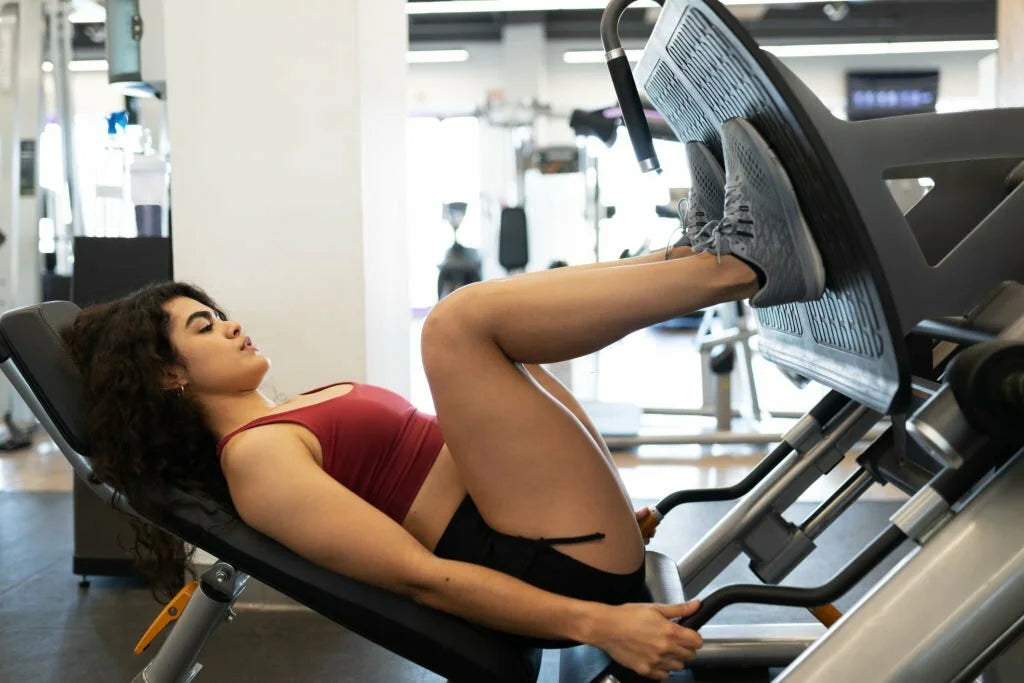6 Barbell Lat Exercises for a Wide Back


To build a powerful, wide back, you’ve got to work your lats. That normally means doing plenty of pulldowns and rows. But what if you’ve only got access to a barbell? No problem – there are at least half a dozen extremely effective lat-developing moves that require nothing but a barbell and some plates.
In this article, I’ll guide you through the six best barbell lat exercises. I’ll also provide my personal trainer tips to help you squeeze the most out of every rep.
Lat Anatomy & Function
Before we dive in on the six most effective barbell lat exercises, let's first understand the anatomy and function of this crucial muscle group. Your lats, short for latissimus dorsi, are the large, fan-shaped muscles that span the width of your back.
The Function of the Lats
- Shoulder Extension: The primary function of the lats is to extend the shoulder joint. This action is what allows you to pull your upper arms down and back, as in a pull-up or pulldown motion.
- Adduction: Lats also assist in the adduction of the humerus, which means they help bring your upper arms closer to the midline of your body. This action is crucial for exercises like rows.
- Stabilization: Beyond the major movements, your lats provide stability to your entire upper body. They act as a foundation for various pressing and pulling movements, ensuring your shoulders and arms work efficiently and safely.
Why Focus on Lats?
Building strong and well-developed lats not only enhances your overall physique but also contributes to functional strength and injury prevention. Whether you're an athlete looking to improve performance or someone seeking a sculpted back, lats are a key player.
Here are 5 reasons to never neglect your lat training:
Postural Improvement
When you strengthen your latissimus dorsi muscles, you will notice postural improvements. This is especially the case if you spend a lot of time sitting or hunched over a computer. Strong lats can help counterbalance the harmful consequences of prolonged sitting or bad posture, reducing the likelihood of developing musculoskeletal problems such as rounded shoulders or forward head posture.
Improved Athletic Performance
Athletes in a variety of sports, including climbers, gymnasts, and swimmers, rely heavily on their lat muscles for power and stability. Stronger lats will produce more force, help maintain muscular balance, and provide the foundation for explosive upper-body movement.
Protection Against Shoulder Injury
Having strong lats contributes to the general stability of the shoulders and can assist in protecting against frequent shoulder problems. They help prevent the likelihood of conditions such as rotator cuff injuries and shoulder impingement by ensuring that the shoulder joint continues to function normally.
Functional Strength
You use your lats in all sorts of everyday movements, including carrying, lifting, and hauling. Strong last will allow you to complete these tasks with less effort and reduced strain on surrounding muscle groups, such as the lower back.
Visual Appeal
Let's not overlook the fact that well-developed muscular lats have a positive impact on a person's appearance. These muscles contribute to the idealized V-taper upper body shape by giving the impression of a smaller waist and larger shoulders than they actually are.
6 Barbell Exercises for Lats
Bent Over Row Barbell Row
Why Do It?
The barbell bent over row is a fundamental exercise for strengthening muscles in your back and shoulders, while also contributing to improved posture, trunk stability, and hip stability. It helps you build strength in the often-neglected posterior chain,
This exercise mimics movements like lifting objects from the ground and pulling your body weight, making it highly functional for daily activities and sports performance.
How To Do It:
- Stand behind a barbell with your feet shoulder-width apart.
- Bend at the hips while keeping your back straight and knees slightly bent. Your body should be at about a 45-degree angle to the ground.
- Grasp the bar a little wider than shoulder width, with your forearms pronated (palms facing your shins).
- Tighten your glutes and core as you pull your elbows up behind you, bringing the bar to your abdomen. Squeeze your shoulder blades together while keeping your back straight.
- Hold this position for a second, then slowly lower the barbell back to the starting position, with your arms extended and the barbell plates just off the ground.
Personal Trainer Tips:
- Start with a manageable weight to ensure proper form. As you become more comfortable, gradually increase the resistance.
- Maintain a strong core and engage your lats throughout the movement to protect your lower back.
- Focus on a controlled tempo, both during the pull and the lowering phase, to maximize muscle engagement.
- Keep your elbows close to your body to target the middle and lower trapezius effectively.
Seal Row
Why Do It?
The seal row eliminates momentum and provides a strict focus on the latissimus dorsi (lats) muscles. This helps target the muscles effectively without relying on swinging or jerking motions. By altering your grip and the path of motion, you can customize the seal row to target different parts of your back, such as your lats, upper back, traps, or rear deltoids.
How To Do It:
- Place a barbell in line with your face when you lie on a high horizontal bench, stacked on weight plates to allow you to grab it comfortably without the plates hitting the floor during the exercise. If you don't have access to a high horizontal bench, you can improvise by stacking one side of a flat bench on plyo boxes, weight plates, or aerobic steps.
- Lie face down on the bench. Lower your legs until they are a few inches off the floor. Grab the bar with a pronated (overhand) shoulder-width grip.
- Slowly unrack the barbell and extend your arms so that they are perpendicular to the floor.
- Pull the bar toward your lower ribs, focusing on using your elbows, not your biceps. Keep your elbows close to your body throughout the movement.
- At the top of the movement, pause and contract your lats before slowly returning to the starting position with your arms fully extended.
Personal Trainer Tips:
- Beginners can stabilize their bodies by placing one end of the bench a few feet away from a wall and positioning their feet flat against the wall, aiding stability and allowing for heavier lifts.
- Consider using a cambered bar for a greater range of motion and control during the exercise.
- Engage your glutes and brace your abs to prevent any hyper-extension of the lumbar spine.
- Make sure the barbell touches the bench with every repetition at the top of the motion.
T-Bar Row
Why Do It?
The T-Bar Row is normally done with a special device consisting of a barbell that has a swivel connection to the floor on one end. However, you can easily create an improvised t-bar set-up with a standard barbell. Place the barbell in the corner of the room, coming out diagonally. Now, place two or three 45-pound plates on the wall end of the bar to weigh it down. Load your plates on the other end. If you have one, use a V-shaped handle to grasp the bar. If not, you can simply wrap your hands around the bar.
The t-bar row falls between a machine and free-weight exercise. While it has a somewhat fixed bar path, it demands quite a lot of stabilization. You can safely load heavy weights with good form to build strength with this exercise.
T-bar rows engage virtually every muscle in your back, as well as the biceps. The primary muscles worked include the latissimus dorsi (lats) and trapezius. Erector spinae muscles also activate isometrically due to the forward-leaning position.
How To Do It:
Load the T-bar with your desired weight.
- Stand with your feet shoulder-width apart, positioning the T-bar between your legs and facing away from the wall.
- Bend at the hips, similar to a deadlift, and grab the handlebar with an overhand grip, hands slightly wider than shoulder-width apart. You should be holding the bar a few inches before the weight plates.
- Come up to a three-quarter stance position, with your torso at a 45-degree angle. Bend forward at the hips, pushing your hips back and keeping your knees slightly bent.
- Pull the loaded bar toward your chest by bringing your elbows back, focusing on using your elbows rather than your biceps. Keep your shoulder blades pulled back and concentrate on driving your chest forward as you pull.
- Lower the bar until your arms are fully extended.
Personal Trainer Tips:
- Focus on driving your chest forward as you pull the bar, maintaining a controlled motion.
- For building strength, use loads at or greater than 85% of your estimated one-rep max (1RM).
- For building mass, use lighter loads, around 70-80% of your estimated 1RM.
Barbell Pendlay Row
Why Do It?
The Barbell Pendlay row, created by USA Weightlifting coach Glenn Pendlay, is a specialized rowing variation designed to enhance back strength and muscular development for weightlifting movements such as snatches, cleans, and deadlifts. This exercise emphasizes strict form, which translates to improved technique in weightlifting-specific pulls.
How to Do It:
- Place the barbell on the floor and stand behind it.
- Bend down to grab the bar with a grip slightly wider than shoulder-width (this is wider than a standard barbell row).
- Hinge your hips, pushing your butt back and lengthening your back. Your torso should be at a 30-degree angle.
- Engage your core as you use your lats to explosively pull the barbell to the base of your chest. Drive your feet into the floor and focus on pulling the barbell towards your hips. Avoid lifting your shoulders or allowing your hips to move forward.
- Lower and Repeat
Personal Trainer Tips
- The Pendlay row is an accessory exercise, so it's not about lifting max weights.
- For Strength: Do 3-5 sets of 4-8 reps with heavy (but submaximal) weight.
- For Muscle Mass: Perform 3-4 sets of 8-15 reps with moderately heavy weight.
- Do not straighten your body during the lift. Maintain the 30-degree torso angle throughout the exercise.
- Avoid excessively flaring your elbows, as this will switch the focus to the arms rather than the lats.
Underhand Bent Over Row
Why Do It?
The underhand bent-over row places more emphasis on the forearm flexors than the extensors. Some people may find this grip more secure and comfortable. This version also forces you to keep your elbows in, helping to prevent the elbow flare problem that is common with the overhand version.
Finally, the underhand grip naturally depresses the scapular, which brings the upper trapezius more into the exercise.
How to Do It:
- Stand behind a barbell with your feet shoulder-width apart.
- Bend at the hips while keeping your back straight and knees slightly bent. Your body should be at about a 45-degree angle to the ground.
- Grasp the bar a little wider than shoulder width, with your forearms supinated (palms facing the ceiling).
- Tighten your glutes and core as you pull your elbows up behind you, bringing the bar to your abdomen. Squeeze your shoulder blades together while keeping your back straight.
- Hold this position for a second, then slowly lower the barbell back to the starting position, with your arms extended and the barbell plates just off the ground.
Personal Trainer Tips
- Keep your core engaged throughout the movement to maintain balance and stability
- Slow down the eccentric (lowering) phase to develop greater grip and biceps strength.
- For Power: Perform 4 sets of 6 explosive repetitions.
- For Hypertrophy: Execute 3-4 sets of 10 repetitions.
- For Endurance: Complete 2 sets with as many repetitions as possible.
- Avoid rounding your back during the movement, as it may strain your lower back and hinder lat engagement.
- Focus on initiating each repetition by engaging the back muscles first, squeezing your shoulder blades, and pulling your elbows back.
- Think "shoulders" before "elbows" in your movement sequence to emphasize back engagement.
Barbell Suitcase Row
Why Do It?
The barbell suitcase row is an explosive exercise that engages multiple muscle groups working together. This compound movement challenges not only your stabilizing muscles but also your core, legs, and back. Despite its seemingly straightforward appearance, mastering this exercise can be challenging. The high-intensity nature of this exercise makes it a favorite among CrossFit athletes.
How to Do It:
- Put a barbell on the floor and stand side on to it on the left side, with your feet shoulder-width apart.
- Bend at the hips and knees to lower your body, keeping your back straight and maintaining a neutral spine.
- Grab the middle of the barbell with your left hand with an overhand grip.
- Pull the barbell up towards your waist. Concentrate on leading the movement with your elbow, engaging your back muscles.
- Pause briefly in the top position.
- Lower the bar under control.
- Perform all your reps on one side, then repeat on the other side.
Personal Trainer Tips
- Focus on keeping your back straight, knees slightly bent, and a neutral spine.
- Avoid rounding your back or arching excessively during the movement.
- This exercise should emphasize controlled movement rather than relying on momentum. Avoid jerking or swinging the barbell to lift it; instead, concentrate on engaging the targeted muscles.
5 Other Effective Exercises for Lats
- Dumbbell Renegade Row
- Kettlebell Renegade Row
- Lat Pulldown
- Single Arm Dumbbell Row
- Barbell Deadlift
10 More Expert Training Tips
- Full Range of Motion: When working your lats with a barbell, you should make it a goal to move through the full range of motion possible. This requires you to fully extend your arms at the peak of the movement while simultaneously contracting your lats at the bottom of the movement. This guarantees that you are engaging the target muscle group for the entirety of the repetition and maximizing the benefits of the exercise.
- Maintain Correct Form: Keeping your form correct is extremely important if you want to minimize the risk of injury and increase the amount of muscle activation. Throughout the entirety of the exercise, you should remember to keep your back straight, your chest up, and your core engaged. You should try to avoid using momentum or swinging the barbell since doing either of these things can take the emphasis off of your lats and put it on other muscles.
- Developing Your Mind-Muscle Connection: Pay close attention to the process of developing a strong mind-muscle connection with your lats. Maintain your focus on the contraction you feel in your lats throughout each and every repetition. To effectively activate your lats, imagine pulling with your elbows while simultaneously squeezing your shoulder blades together. This will help you visualize the movement.
- Monitor Your Tempo: Keep a close eye on the pace at which you are performing your repetitions. First, carefully and under control, bring the barbell all the way down to your starting position. Then, using deliberate, controlled force, bring it back up to your starting position. This slow and regulated speed helps maximize the amount of time spent under tension, which is critical for achieving optimal muscular growth.
- Change the Width of Your Grip: Experiment with holding the barbell with a variety of grip widths to target different portions of your latissimus dorsi muscle. A wider grasp places more emphasis on the outer lats, but a closer hold has the potential to engage the inner lats. In order to achieve well-rounded development, you should incorporate both of these variations within your workouts.
- Progressive Overload: To stimulate muscle growth and enhance strength, gradually increase the amount of weight or resistance you are working with. Increase the weight and lower rep count on each set, starting with about 20 reps on the first set and working down to 6 reps on your heaviest set.
- Include Compound Movements: Exercises that involve compound movements, such as bent-over rows and deadlifts, work not only your lats but also several other muscle groups. If you incorporate these exercises into your regimen, you’ll experience general back development as well as functional strength gains.
- Vary Your Exercises: Instead of focusing solely on one barbell exercise for your back, try a few different variations. Alternate between a variety of exercises so that you can test your muscles from a number of different aspects and avoid your progress from becoming stagnant.
- Warm-Ups Before Beginning Your Workout: Combine dynamic stretches with mobility exercises for your shoulders and back. This will prepare your muscles and joints for the intense work ahead.
- Make Room for Recovery: Remember that your muscles get bigger and stronger during the rest and recovery time between workouts. I recommend working your lats twice weekly, with at least a two-day gap between workouts, such as Monday and Thursday.
Conclusion
You’ve now got a powerful arsenal of barbell-only lat exercises to form the basis of your upper back workouts. Supplementary barbell exercises for lats include the barbell pullover, and the kroc row. If you have other equipment available, add a cable pulldown exercise like a lat pulldown and pull-ups to round out your program.
For best results, do 12-14 sets for lats, with reps ranging from 20 down to 6, increasing the resistance on each succeeding set. Work your lats twice per week, with at least 48 hours of rest between sessions to allow for sufficient rest and recovery.
What’s your favorite lat exercise device - cables, barbells, or machines? Let us know in the comments section below.


